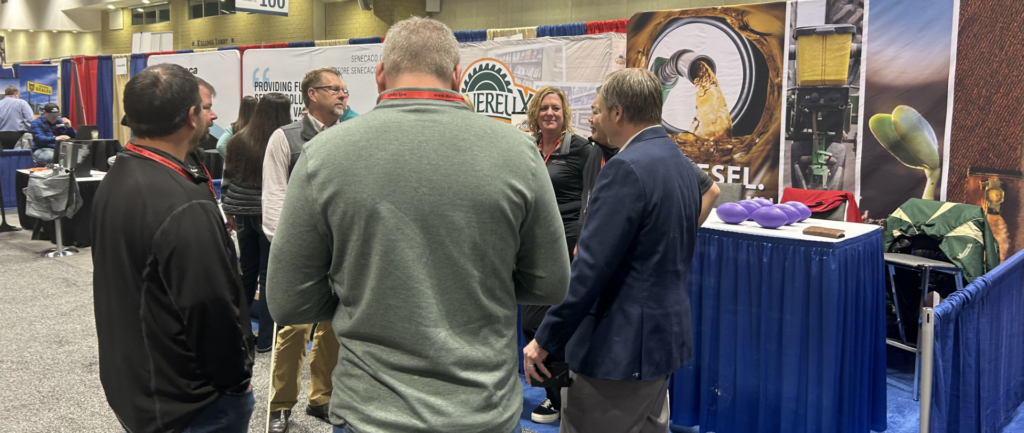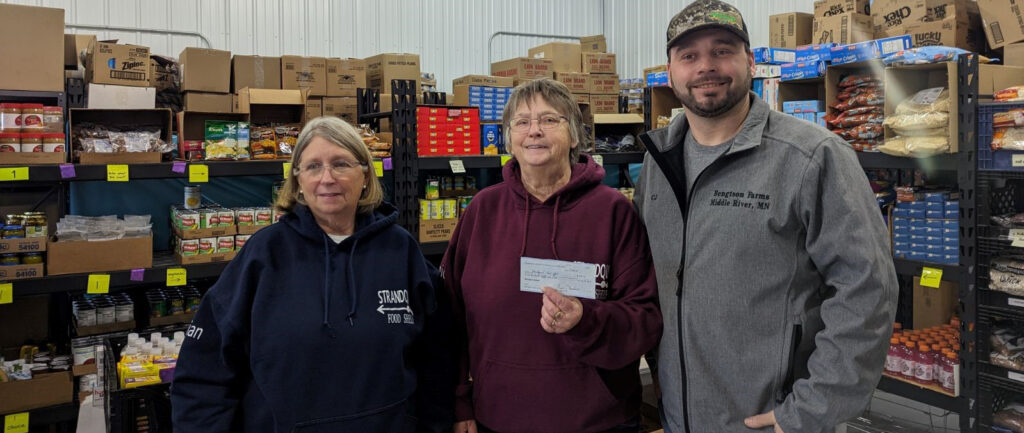When the late Elmore Leonard suggested to never open a story with a weather reference, it’s safe to say the legendary author never experienced winter in Grand Forks, N.D.
Fortunately for the farmers of the Red River Valley, a little cold weather is a good excuse to get caught up on the latest soybean, wheat, barley and grain research.
That’s exactly what happened Wednesday and Thursday at the 2019 Prairie Grains Conference held at the Alerus Center.
“While the temperature is usually below zero, the conversation and networking are always hot at Prairie Grains,” joked Kris Folland, Minnesota Soybean Research & Promotion Council (MSR&PC) director for Districts 1, 2 & 3 in northern Minnesota. “Seriously though, Prairie Grains is an example of an event the Council invests in, because it is an investment in the growers who pay the checkoff.”
The 7th annual On-Farm Research Summit kicked off the conference, with Minnesota Wheat’s On-Farm Research Coordinators Melissa Geiszler and Lauren Proulx taking a packed room through the past year’s research on:
- Wheat
- Seeding rate
- Flag-leaf fungicide
- N-stabilizer
- Sulfur application
- Elevated P and K fertility
- Soybeans
- Seeding rate
- R3 Fungicides
- Production Ag Research
- Variable Rate N application
- Within-field protein variability (wheat)
- Cover Crops and Tillage
- Vertical vs. conventional tillage
- ‘Green seeding’ soybean into rye
- Oats to reduce IDC
When it comes to using oats as a cover crop to soybeans, Geiszler told attendees they saw a small reduction in the impact of iron deficiency chlorosis, but they also saw a decline in yield, which she attributed to the oats stealing more water than expected from the soybeans.
Geiszler indicated better results in seeding soybeans into fall rye.
“It’s a practice that has been around for a very long time,” she said, “and proved to work when managed properly.”
The goal of this project, which is funded in part by soybean checkoff dollars, is to see if rye can reduce IDC while also helping to control weeds. Unfortunately, Geiszler said, a wet fall made planting rye difficult. Many farmers had expressed interest in participating in the project, but Mother Nature had other plans.
“We were very thankful to get at least two locations in,” she said.
The rye did suffer from extensive rains after planting, so the goal now shifts to spring where producers will plant soybeans before terminating the rye. When they terminate will vary.
“We’re leaving it up to the producers to make it easiest for them as we dabble with cover crops,” she said.
A farmer from Wilkin County interjected and said seeding in barley helped them reach a gain of 5 bushels an acre on their soybean fields, and his local co-op reported a reduction in IDC impact.
“Whether you use oats, rye, barely or whatever you plant, what we’re really going for is having extra roots in the soil,” Geiszler responded.
Folland pointed to the On-Farm research as an example of wise checkoff investments.
“Solving agronomic issues from weed resistance to disease to Soybean Cyst Nematode is the goal of our production research,” he said. “Prairie Grains also gives us an opportunity for partnerships and networking with commodity groups and private groups, and most importantly, we can have grower-to-grower interaction.”
Northern county soybean meeting
A staple of Prairie Grains is bringing together various commodities and allowing time for updates. While the Minnesota Soybean Growers Association and MSR&PC don’t hold annual meetings at the event, both take part in a meeting with the organized soybean counties of northern Minnesota.
Folland gave a Council update while MSGA President Jamie Beyer informed growers about MSGA’s legislative wins last session while laying out the early road map to the 2020 legislative session, which she admitted will be a grind.
“After Gov. Dayton, we weren’t sure what to expect with Gov. Walz,” she said. “I remember getting to the end of the legislative session and not being sure how things would go, and when everything settled, I thought, ‘That wasn’t so bad.’”
Beyer said the 2020 session won’t be as fruitful as 2019. With an election year looming and control of the Minnesota senate up for grabs, Beyer cautioned growers it will be a grind at the Capitol, with many things getting caught up in election politics.
The Commish speaks
Minnesota Department of Agriculture Commissioner Thom Petersen addressed attendees to open Thursday’s show. MDA is a sponsor of the On-Farm Research event, and Petersen told attendees he knows 2019 was challenging, but he also sees opportunities.
“We asked for the declaration for the 12 counties in the northwest,” he said, referring to Gov. Tim Walz’ request for disaster for farmers in need due to difficult harvest conditions. “We’re still waiting to hear. I’m hopeful we’ll hear a decision soon, whether it is this week or next week. USDA has been compiling those numbers. We are also looking at adding three counties as we look at some of the numbers from the southern part of the state.”
Petersen commended the work of farm groups and encouraged farmers to take get involved with the commodity groups impacting their farms.
Prairie Grains, in its 45th year, though not always under the name Prairie Grains Conference, wrapped up Thursday with additional research reporting sessions, a weather outlook from WDAY Chief Meteorologist John Wheeler, and a daylong trade show.







